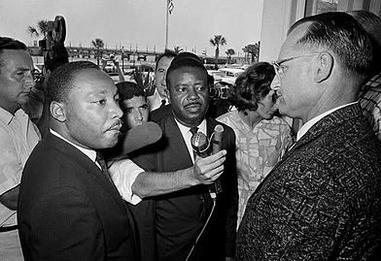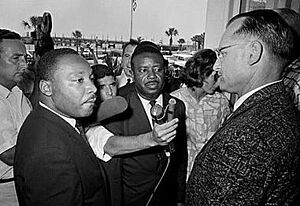St. Augustine movement facts for kids
Quick facts for kids St. Augustine movement |
|||
|---|---|---|---|
| Part of the Civil Rights Movement | |||

Martin Luther King Jr. being denied entry to the "whites-only" Monson Motor Lodge restaurant by owner James "Jimmy" Brock
|
|||
| Date | 1963–1964 (2 years) | ||
| Location | |||
| Resulted in |
|
||
| Parties to the civil conflict | |||
|
|||
| Lead figures | |||
|
|||
The St. Augustine movement was an important part of the larger Civil Rights Movement in the United States. It happened in St. Augustine, Florida, from 1963 to 1964. This movement helped lead to the creation of the Civil Rights Act of 1964, a major law that made segregation illegal.
Contents
Why the St. Augustine Movement Started
Even after the Supreme Court ruled in 1954 that "separate but equal" schools were unfair, St. Augustine still kept schools separate for black and white children. By 1964, only six black children were allowed into white schools. Some families who tried to send their children to these schools faced serious problems. Their homes were burned, or parents lost their jobs, forcing them to leave the area.
A City's 400th Birthday Celebration
St. Augustine was getting ready to celebrate its 400th birthday in 1965. This big event was expected to get attention from all over the world. However, city leaders did not include African Americans in the planning. The celebrations focused on the city's Spanish past, ignoring the history of slavery and the unfair Jim Crow laws that were still in place.
Life in St. Augustine for Black Residents
St. Augustine had about 15,000 people and relied a lot on tourists. About 23% of the people were black. But segregation and Jim Crow laws stopped them from having a say in local government or business.
Key Moments in the Movement
Dr. Robert Hayling's Leadership
Dr. Robert Hayling, a dentist, is seen as the "father" of the St. Augustine movement. He was the first black dentist in Florida to join the American Dental Association. In 1960, he started his practice in St. Augustine and joined the local National Association for the Advancement of Colored People (NAACP).
Under his leadership, the NAACP chapter grew. They pushed the local government to end segregation. In 1963, as the city prepared for its 400th anniversary, they asked Vice President Lyndon B. Johnson to cancel his visit unless he spoke to a mixed-race audience. This effort worked, but it did not change the Jim Crow laws.
Hayling believed that direct action was needed. He started an NAACP Youth Council that used peaceful protests, like "wade-ins" at segregated swimming pools.
The St. Augustine Four
On July 18, 1963, a sit-in protest happened at a Woolworth's lunch counter. Sixteen young black protesters and seven younger children were arrested. They were offered a deal: be released if they promised to stop protesting. Four of the children, JoeAnn Anderson, Audrey Nell Edwards, Willie Carl Singleton, and Samuel White, refused. They became known as "the St. Augustine Four."
These four children were sent to a "reform" school for six months. Their unfair treatment was shared by famous people like Jackie Robinson and the NAACP. Finally, in January 1964, the governor of Florida helped free them.
Protecting Protesters
The St. Augustine movement also involved protecting its members. In 1963, the NAACP asked the government to stop funding the city until it followed civil rights laws. This led to threats against activists from the Ku Klux Klan (KKK). Dr. Hayling and his group sometimes used weapons to defend themselves when the Klan attacked black neighborhoods.
In September 1963, the Klan attacked Dr. Hayling and three other NAACP activists. They were beaten but rescued by police. Sadly, charges against the Klansmen were dropped, but Hayling was found guilty of "assaulting" the KKK crowd.
After this, tensions grew. When Klan members shot into homes in a black neighborhood, one Klansman was killed when people shot back. Because of Hayling's strong stance, the national NAACP removed him from his leadership role. Hayling and others then asked the Southern Christian Leadership Conference (SCLC), led by Martin Luther King Jr., for help.
Spring Break Protests Bring Attention
In spring 1964, Dr. Hayling invited college students from the North to come to St. Augustine for spring break. Instead of going to the beach, they joined civil rights activities. Four important women from Boston also joined, including Mrs. Mary Parkman Peabody, the 72-year-old mother of the governor of Massachusetts.
On April 1, 1964, Mrs. Peabody was arrested with a mixed group at a motel. This event made the St. Augustine movement famous around the world. For months, the city received more attention than ever before. Dr. King and other SCLC leaders, like Ralph Abernathy and Andrew Young, led large peaceful protests.
Facing More Violence
From May to July 1964, protesters faced insults and attacks. They marched nightly down King Street, where white segregationists often attacked them. Hundreds of marchers were arrested. The jail became so full that some people were held outside in a hot, uncovered area. When protesters tried to go to the beaches, they were beaten and pushed into the water. Some protesters could not swim and had to be saved by others.
Dr. King himself faced many threats. In early June, a house where he was supposed to stay burned down. Dr. Hayling's team increased their armed patrols to protect King, even though King preferred nonviolence.
The Monson Motor Lodge Protests

St. Augustine was the only place in Florida where Dr. King was arrested. This happened on June 11, 1964, at the Monson Motor Lodge. From jail, he wrote a letter asking rabbis to come to St. Augustine and join the movement. On June 18, 1964, 17 rabbis were arrested at the Monson motel. This was the largest mass arrest of rabbis in American history.
The protests reached a peak when black and white protesters jumped into the swimming pool at the Monson Motor Lodge. The hotel manager, James Brock, poured what he said was acid into the pool. Pictures of this, and of a policeman jumping into the pool to arrest the protesters, were shown around the world. These images helped show the world the harsh reality of segregation.
What Happened Next
A Step Towards Peace
On June 30, Florida Governor Farris Bryant announced a committee with both black and white members to help St. Augustine communicate better. Even though problems were not fully solved, national SCLC leaders left St. Augustine on July 1. The very next day, President Lyndon Johnson signed the Civil Rights Act into law.
Continued Challenges for Black Residents
Despite the new law, black residents in St. Augustine still faced violence and threats. The Klan continued to protest, and many businesses stayed segregated. Dr. Robert Hayling's dental practice lost many white patients, and his family's safety was at risk. In 1966, he moved to another city in Florida.
Florida Normal Industrial and Memorial College, a black college whose students had joined the protests, felt unwelcome in St. Augustine. In 1965, the school bought land in Dade County and moved there in 1968. Today, it is known as Florida Memorial University.
Lasting Impact
Monson Motor Lodge Site
The Monson Motor Lodge and its famous swimming pool were torn down in 2003, even after five years of protests to save it. A Hilton Hotel was built there instead. In 2003, the mayor of St. Augustine honored Robert Hayling for his work, and a street was named after him.
St. Augustine Foot Soldiers Monument

The St. Augustine Foot Soldiers Monument stands in a historic public park. This monument honors the people who marched and protested for civil rights in St. Augustine. It was unveiled on May 14, 2011.
The Resilience: Black Heritage in St. Augustine Project
Resilience: Black Heritage in St. Augustine is a project that celebrates the many ways the Black community has helped build St. Augustine's culture over more than 455 years. In 2021, many local museums, libraries, and archives worked together on this project. They hosted programs, talks, and tours. They also created a website with educational materials. The project's symbol is a bell, which stands for freedom and liberty.

